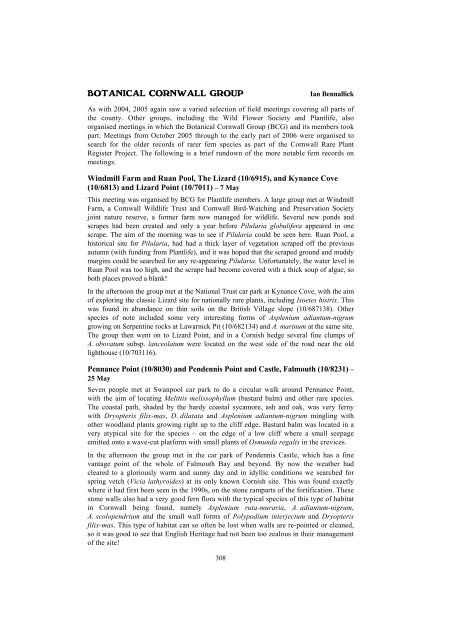REGIONAL MEETINGS - Natural History Museum
REGIONAL MEETINGS - Natural History Museum
REGIONAL MEETINGS - Natural History Museum
You also want an ePaper? Increase the reach of your titles
YUMPU automatically turns print PDFs into web optimized ePapers that Google loves.
BOTANICAL CORNWALL GROUP Ian Bennallick<br />
As with 2004, 2005 again saw a varied selection of field meetings covering all parts of<br />
the county. Other groups, including the Wild Flower Society and Plantlife, also<br />
organised meetings in which the Botanical Cornwall Group (BCG) and its members took<br />
part. Meetings from October 2005 through to the early part of 2006 were organised to<br />
search for the older records of rarer fern species as part of the Cornwall Rare Plant<br />
Register Project. The following is a brief rundown of the more notable fern records on<br />
meetings.<br />
Windmill Farm and Ruan Pool, The Lizard (10/6915), and Kynance Cove<br />
(10/6813) and Lizard Point (10/7011) – 7 May<br />
This meeting was organised by BCG for Plantlife members. A large group met at Windmill<br />
Farm, a Cornwall Wildlife Trust and Cornwall Bird-Watching and Preservation Society<br />
joint nature reserve, a former farm now managed for wildlife. Several new ponds and<br />
scrapes had been created and only a year before Pilularia globulifera appeared in one<br />
scrape. The aim of the morning was to see if Pilularia could be seen here. Ruan Pool, a<br />
historical site for Pilularia, had had a thick layer of vegetation scraped off the previous<br />
autumn (with funding from Plantlife), and it was hoped that the scraped ground and muddy<br />
margins could be searched for any re-appearing Pilularia. Unfortunately, the water level in<br />
Ruan Pool was too high, and the scrape had become covered with a thick soup of algae, so<br />
both places proved a blank!<br />
In the afternoon the group met at the National Trust car park at Kynance Cove, with the aim<br />
of exploring the classic Lizard site for nationally rare plants, including Isoetes histrix. This<br />
was found in abundance on thin soils on the British Village slope (10/687138). Other<br />
species of note included some very interesting forms of Asplenium adiantum-nigrum<br />
growing on Serpentine rocks at Lawarnick Pit (10/682134) and A. marinum at the same site.<br />
The group then went on to Lizard Point, and in a Cornish hedge several fine clumps of<br />
A. obovatum subsp. lanceolatum were located on the west side of the road near the old<br />
lighthouse (10/703116).<br />
Pennance Point (10/8030) and Pendennis Point and Castle, Falmouth (10/8231) –<br />
25 May<br />
Seven people met at Swanpool car park to do a circular walk around Pennance Point,<br />
with the aim of locating Melittis melissophyllum (bastard balm) and other rare species.<br />
The coastal path, shaded by the hardy coastal sycamore, ash and oak, was very ferny<br />
with Dryopteris filix-mas, D. dilatata and Asplenium adiantum-nigrum mingling with<br />
other woodland plants growing right up to the cliff edge. Bastard balm was located in a<br />
very atypical site for the species – on the edge of a low cliff where a small seepage<br />
emitted onto a wave-cut platform with small plants of Osmunda regalis in the crevices.<br />
In the afternoon the group met in the car park of Pendennis Castle, which has a fine<br />
vantage point of the whole of Falmouth Bay and beyond. By now the weather had<br />
cleared to a gloriously warm and sunny day and in idyllic conditions we searched for<br />
spring vetch (Vicia lathyroides) at its only known Cornish site. This was found exactly<br />
where it had first been seen in the 1990s, on the stone ramparts of the fortification. These<br />
stone walls also had a very good fern flora with the typical species of this type of habitat<br />
in Cornwall being found, namely Asplenium ruta-muraria, A. adiantum-nigrum,<br />
A. scolopendrium and the small wall forms of Polypodium interjectum and Dryopteris<br />
filix-mas. This type of habitat can so often be lost when walls are re-pointed or cleaned,<br />
so it was good to see that English Heritage had not been too zealous in their management<br />
of the site!<br />
308
















